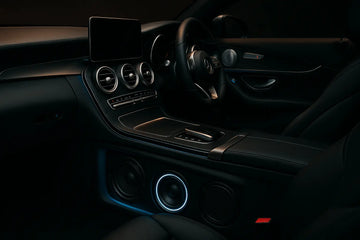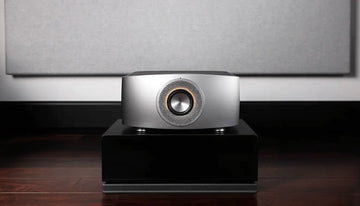Coaxial Speakers
Related Collections:
Featured Products
Xcelsus XP620 Primum 6.5" 2 Way Coaxial Set
Polk DB462 4x6" Coaxial Speakers with Marine Certification
Eton PRX 110 100 mm (4 inch) coaxial system
Ground Zero GZIF 40X 4″ 2-way coaxial speaker system
Polk DB402 4" Coaxial Speakers with Marine Certification
Xcelsus XP620 Primum 6.5" 2 Way Coaxial System
Audio Dynamics ADCX513 5.25" Coaxial Speaker Set
Audio Dynamics 2000 Series 5.25″ Coaxial Set – CX524
Rainbow Audio EL-X165S 2-Way 6.5-inch (165mm) Coaxial Speakers
Eton PRX 140.2
Audiocircle SL-X6 6.5" 2-Way Coaxial Speakers
Upgrade Your Ride: Discover the Best Coaxial Car Speakers

Welcome to the definitive guide for transforming your car's audio system. If you're tired of the flat, muddy sound from your factory speakers, you're in the right place. The right equipment can turn a daily commute, weekend road trip, or quick drive to the store into a private concert. For most drivers, the most impactful and cost-effective upgrade is a new set of coaxial car speakers.
So, what are they? In short, coaxial speakers are an all-in-one audio solution that combines multiple components into a single, easy-to-install unit. Their main benefit is a huge improvement in sound quality without the cost or complexity of a separate component system. This guide will help you understand how these speakers work and how to choose the perfect pair for your vehicle. Afterward, you'll be ready to explore our product listings with confidence and find the sound you've been missing.
Understanding Coaxial Car Speakers: What Are They?
At its core, a coaxial speaker is a full-range system designed for simplicity and efficiency. The name "coaxial" means its components share a common axis. In this design, the tweeter (the small driver for high-frequency sounds like cymbals) is mounted directly in the center of the woofer (the larger cone for bass and midrange frequencies). This "speaker-within-a-speaker" layout is the key to its convenience.
This integrated structure is different from component speaker systems, where the woofer, tweeter, and crossover (an electronic filter that directs frequencies to the correct driver) are all separate parts. While component systems can offer superior sound imaging if installed correctly, they require custom tweeter mounting and more complex wiring. Coaxial speakers, however, are designed as direct, drop-in replacements for your car's factory speakers. They fit the same space, use the same mounting holes, and connect with simple adapters, making them a perfect DIY project.
Coaxial speakers are typically described as either "2-way" or "3-way":
-
2-Way Coaxial Speakers: This is the most common type, featuring a woofer and a tweeter. The woofer handles low and midrange frequencies, while the tweeter manages the highs. A simple, built-in crossover directs the signals to ensure each component works effectively.
-
3-Way Coaxial Speakers: These add a third driver—a dedicated midrange cone—between the woofer and tweeter. This provides more detail and clarity in the vocal and instrumental range, freeing up the woofer to focus on lower bass notes. Some designs use a "supertweeter" instead of a midrange to handle ultra-high frequencies. While a high-quality 2-way speaker can often outperform a budget 3-way, a premium 3-way model can offer an exceptionally rich and detailed sound.
Why Choose Coaxial Car Speakers for Your Vehicle?
Upgrading your factory speakers to a quality set of aftermarket coaxial car speakers is one of the most rewarding improvements you can make to your vehicle. Automakers often cut costs on stock audio systems, using speakers with cheap paper cones and small magnets that can't reproduce music with true fidelity. The benefits of making the switch are both immediate and dramatic.
The most significant advantage is the vastly improved sound quality. Here’s what you can expect:
-
Clearer Highs and Defined Mid-Range: With dedicated tweeters made from superior materials like silk or PEI, you'll hear crisp, clear highs without the harshness of factory speakers. Vocals and instruments will sound more present and detailed, letting you hear nuances in your favorite songs that you may have missed before.
-
Enhanced Bass Response: Aftermarket coaxial speakers use rigid, durable cone materials like polypropylene or woven glass fiber. These materials resist flexing and distortion, producing tighter, punchier, and more accurate bass than the flimsy paper cones in stock speakers.
-
A Richer, More Balanced Audio Experience: Together, these elements deliver a complete, full-range sound that is balanced from top to bottom. Music no longer sounds like it's coming from one spot but instead fills the cabin with a richer, more immersive soundscape.
Beyond sound quality, their ease of installation makes them a top choice. Since they are designed as factory replacements, they often require no cutting or drilling, making them an ideal weekend project for anyone comfortable with basic tools. This simplicity also makes them cost-effective. You get a complete audio solution in one package, avoiding the higher product costs and professional installation fees of complex component systems. Versatility is another key selling point, as a vast range of standard sizes means there's a coaxial speaker to fit almost any car.
How to Select the Right Car Speakers Coaxial for Your Needs
Choosing the right car speakers coaxial might seem daunting with all the technical specs, but it's straightforward once you know what to look for. Focusing on a few key features will ensure you get a set that matches your car's audio system and your listening habits.
Power Handling (RMS vs. Peak): This is arguably the most important spec. Ignore Peak Power—it's a marketing figure for short bursts. Focus on the RMS (Root Mean Square) power rating, which indicates the continuous power a speaker can handle. If you're using a factory or standard aftermarket stereo (which usually outputs 14-22 watts RMS per channel), choose speakers with a lower RMS rating (e.g., 2-50 watts RMS). If you have an external amplifier, match the speakers' RMS rating to the amp's output to prevent distortion and damage.
Sensitivity: Speaker sensitivity measures how efficiently a speaker converts power into sound, measured in decibels (dB). If you are not using an external amplifier, this is a critical specification. A speaker with high sensitivity (90 dB or higher) needs less power to produce volume, making it ideal for lower-powered factory stereos. If you have a high-powered amplifier, sensitivity is less of a concern.
Frequency Response: This tells you the range of sounds the speaker can reproduce, from low bass to high treble (e.g., 45Hz - 22,000Hz). A wider range is generally better. Pay attention to the lower number (in Hz); a smaller number suggests the speaker can produce deeper bass tones.
Materials Matter: The materials used for the woofer cone and tweeter dome directly impact the sound.
-
Woofer Cones: Polypropylene is a popular choice, offering a great blend of durability and sound quality. Stiffer, more lightweight materials like woven glass fiber, carbon fiber, or metal-matrix composites provide a quicker response for more accurate, punchy bass, but typically come at a higher price.
-
Tweeter Domes: Silk, textile, or poly domes produce warm, smooth, and refined high-frequency sounds. If you prefer brighter, more vibrant highs, look for tweeters made of metal (aluminum, titanium) or hard composites like PEI (Polyetherimide), which offer excellent clarity and durability.
Impedance: This is a measure of electrical resistance, almost always listed in ohms. The vast majority of car audio speakers have an impedance of 4 ohms, which is the standard for car stereos and amplifiers. It's good practice to confirm, but you'll rarely find a mismatch with modern equipment.
Installation Guide: Getting Your New Coaxial Speakers Ready
Installing new coaxial speakers is a manageable DIY project that you can complete in an afternoon. While every vehicle is different, the general process is the same. Disclaimer: Always consult a vehicle-specific guide or video for detailed instructions on your make and model.
First, gather your tools. You will need a set of screwdrivers, a socket set, a plastic panel removal tool kit (highly recommended to avoid scratches), and wire strippers/crimpers. The first step is to safely remove the door panel or trim covering the speaker. Look for hidden screws in door handles, armrests, or behind small plastic covers. Once all screws are out, use your panel tool to gently pry the panel's edges and release the plastic clips. Disconnect any electrical harnesses for windows or locks and set the panel aside.
Next, tackle the wiring. The most critical step is maintaining correct polarity: the positive (+) wire from your car must connect to the speaker's positive terminal, and negative (-) to negative. Reversing this will put the speaker "out of phase," causing thin sound and a major lack of bass. To simplify this and avoid cutting factory wires, buy a vehicle-specific wiring harness adapter. This plugs directly into your car's connector for a clean connection to your new speaker. Always secure connections with crimp connectors or solder—never just twist and tape them.
You might also need speaker adapter rings. If your new speaker's mounting holes don't align with the factory spots, these plastic or MDF rings bridge the gap for a secure, vibration-free fit. Once the speaker is mounted and wired, test it! Before reassembling everything, turn on your stereo and use the balance and fader controls to confirm the new speaker works correctly. Once you've confirmed it works, carefully reinstall the door panel. If this process seems overwhelming, a professional installer can do the job quickly and correctly.
Common Questions About Coaxial Car Speakers
Can I replace my factory speakers with coaxial ones?
Yes, absolutely. This is exactly what they are designed for. The most important factor is matching the physical size (e.g., 6.5-inch, 6x9-inch). You may need a simple mounting adapter bracket and a wiring harness adapter to make the installation a "plug-and-play" process without permanently modifying your vehicle.
Do I need an amplifier for coaxial speakers?
Not always. Many coaxial speakers have high sensitivity, meaning they work well with the lower power from a factory or standard aftermarket stereo. However, an external amplifier will always bring out the best in any speaker. An amp provides clean power, letting speakers play louder without distortion and with better bass control. It's a fantastic next-step upgrade.
What's the difference between 2-way and 3-way coaxial speakers?
A 2-way speaker has two drivers: a woofer for low/mid frequencies and a tweeter for highs. A 3-way speaker adds a third driver dedicated to midrange frequencies. In theory, this adds more detail to the vocal range. In practice, a high-quality 2-way speaker from a reputable brand will often sound much better than a cheap, poorly designed 3-way speaker.
How do I know what size speakers fit my car?
The most reliable method is using an online vehicle fit guide. Just enter your car's make, model, and year to see compatible speaker sizes for each location (front doors, rear deck, etc.). You can also check your owner's manual, search online forums for your car model, or carefully remove an existing speaker and measure it.
Are coaxial speakers better than component speakers?
It depends on your goals and budget. Coaxial speakers are the clear winner for value, simplicity, and ease of installation. They offer a huge improvement over stock sound for a reasonable price. Component speakers, with their separate drivers and external crossovers, provide superior sound quality, better stereo imaging (the sense of space in the music), and more customization options. However, they are more expensive and require a much more involved installation. For most people, coaxial speakers are the perfect choice.
Find Your Perfect Sound: Shop Our Coaxial Speaker Collection
You now have the knowledge to make a confident, informed decision. Upgrading to a new set of coaxial car speakers is the single best step toward a truly enjoyable in-car audio experience. You’ll rediscover your favorite music with new clarity, depth, and impact, turning your daily drive from a chore into a pleasure. By understanding power handling, sensitivity, and material quality, you can cut through the marketing hype and focus on the specs that really matter for your setup.
Your journey to better sound starts now. It's time to put that knowledge into action by browsing our extensive collection of high-quality coaxial speakers from the industry's most trusted brands. Use our filters to search by size, brand, price, and other key features to find the perfect match for your vehicle and budget. Your perfect sound is just a few clicks away.
Explore our complete selection of coaxial car speakers today and hear what you've been missing! If you have any questions, our team of audio experts is ready to help you find the ideal solution for your ride.
Coaxial Speakers
Frequently Asked Questions
What are coaxial speakers?
What are the advantages of coaxial speakers?
What is the price range for coaxial speakers?
How do coaxial speakers compare to component speakers?
Related Articles

Loudspeakers for Cars: Complete Guide to Upgrading Your Vehicle’s Audio System

Best Car Sub and Speakers for Every Budget in 2025

Best Focused Speaker Technology for Superior Sound Precision














